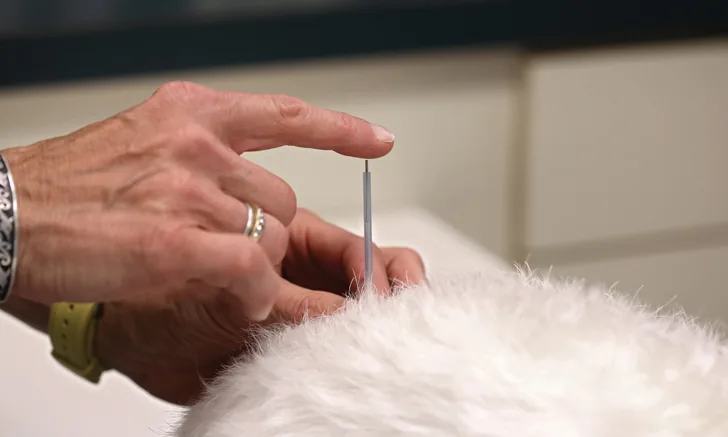Acupuncture in Conventional Cancer Care
Kendra V. Pope, DVM, DACVIM (Oncology), CVA, CVCH, CVFT, CVTP, Red Bank Veterinary Hospital, Tinton Falls, New Jersey

History
Rigby, a 9-year-old, neutered male golden retriever, was presented for evaluation of a firm swelling under his chin. Rigby was otherwise healthy with a normal appetite and energy level.
Examination
Rigby was friendly, bright, alert, and responsive. Multiple firm, enlarged peripheral lymph nodes were appreciated in the mandibular, superficial cervical, popliteal, and inguinal regions. Cardiopulmonary auscultation was normal. Temperature and vital signs were within normal limits. No other abnormalities were identified.
Diagnostic Results
Fine-needle aspiration was conducted on all enlarged peripheral lymph nodes. Evaluation of in-house cytology revealed a population of monomorphic round cells 2× to 3× the size of an RBC. Large-cell lymphoma was confirmed by a clinical pathologist.
Potential treatment options, including chemotherapy protocols and palliative care with corticosteroids, were discussed with the owner. The owner was interested in pursuing conventional treatment and asked about other methods to support Rigby through chemotherapy. As a cancer survivor, the owner had found complementary therapy beneficial in increasing her quality of life during treatment and desired the same care for her pet.
Ask Yourself
Complementary and alternative medicine (CAM) treatment modalities (eg, acupuncture, massage techniques, nutritional counseling, dietary supplements) are used in human medicine to complement conventional cancer care; they are commonly integrated into treatment plans to decrease pain, anxiety, and fatigue and to combat side effects of chemoradiation therapy.1
Although evidence regarding the benefits of these modalities in veterinary oncology is lacking, a 2006 survey revealed that 76% of owners of pets with cancer reported using some form of CAM.2 Of these owners, only 46% used CAM because of a veterinarian’s recommendation. The remaining 54% made treatment decisions based on advice from family or friends, the internet, books, or other sources (eg, breeders, health food stores, television).2 Despite a lack of evidence in the veterinary literature, clients are seeking CAM modalities and looking to veterinarians for knowledge and advice.
As research in veterinary oncology, and specifically the use of CAM, continues, similar benefits as those noted in humans receiving integrative cancer care can be expected for veterinary patients.
Acupuncture in Cancer Care3
Based on the principles of traditional Chinese medicine, acupuncture needle placement allows energy known as chi to flow freely throughout channels, or meridians, which may relieve blockages thought to cause pathology or disease.1 The neurophysiologic effects of acupuncture are mediated locally and distantly by endorphins, endogenous opioids, anti-inflammatory cytokines, and monoamine neurotransmitters; they likely work via interplay among connective tissue, neurologic pathways, lymphatics, and the vascular system.4
There are no publications regarding acupuncture use in veterinary oncology.3 Clinical research in human oncology shows that acupuncture has significant therapeutic value and helps reduce common physical and emotional side effects associated with cancer and its treatment.5 In 2009, the Society for Integrative Oncology published clinical practice guidelines regarding the use of complementary therapies and botanicals in human cancer care1; acupuncture was strongly recommended as a complementary therapy in human oncology when1:
Pain is poorly controlled
Side effects from treatment are clinically significant
Chemotherapy-induced nausea and vomiting are poorly controlled
Reducing pain medication becomes a clinical goal
Other reports also support the use of acupuncture for:
Chemotherapy-induced neuropathy6
Nausea and vomiting7,8
Xerostomia9,10
Chemotherapy-induced fatigue11
Neutropenia and leukopenia<sup12,13 sup>
Hot flashes5,13
Pain associated with aromatase inhibitor use13
Lymphedema14
Treatment-related sleep disturbances15
Treatment-related anxiety and depression15
Immunomodulation16
Although continued research and well-designed clinical trials are needed to definitively support acupuncture use in these adjunctive settings—because of rare contraindications and a lack of concern for safety when performed by a qualified practitioner—potential applications are vast. Caution should be exercised in patients with bleeding tendencies. However, all of the reports found acupuncture safe for cancer patients, with minor soreness or bruising reported as the most common adverse event.6-16
The Take-Home
Integrative oncology provides patient-centered care through available treatment modalities using both Western medicine and CAM to achieve optimal health and healing.
Benefits of acupuncture for veterinary cancer patients are expected to mirror those in human cancer patients. Continued investigation into other integrative treatment modalities in veterinary oncology will continue to support the One Health Initiative and benefit humans and animals alike in all aspects of comprehensive cancer care.
CAM = complementary and alternative medicine